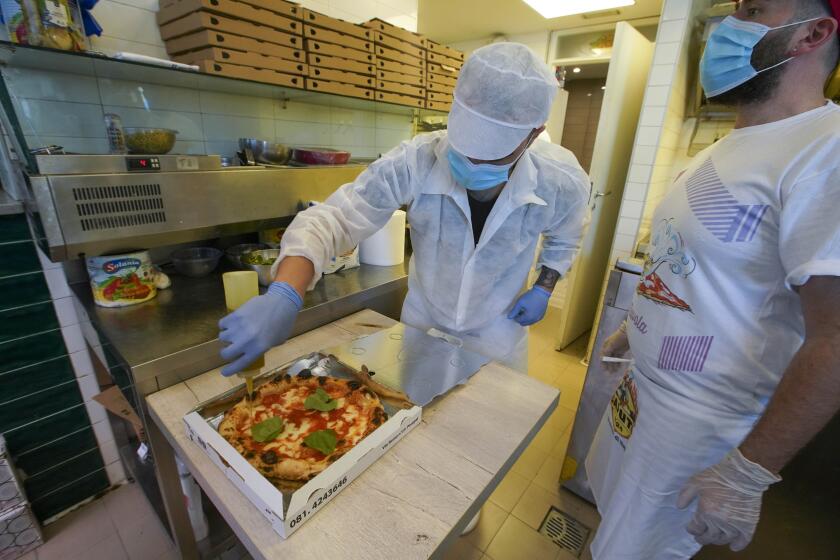What leaving lockdown looks like in coronavirus-ravaged Europe

- Share via
PARIS — Europeans are starting to venture outside after weeks of confinement, scarred emotionally by a virus that has overwhelmed some of the world’s best healthcare systems and killed more than 120,000, yet yearning to rediscover signs of normalcy.
Leaving lockdown looks different in Berlin than it does in Madrid, however, as each government sets its own rules and pace for letting the continent’s half a billion people taste freedom again. Here’s a look at some of the measures being rolled out:
FRANCE
France outlined a plan Tuesday to open up some shops, farmers markets, schools, nurseries and small museums starting May 11 — but only if the country can keep infections under control.
Restaurants, parks, major museums and other businesses that underpin the all-important tourism economy will stay shuttered until at least June 2. French people, currently confined close to home, will be allowed to travel starting May 11, but only up to 60 miles away.
To ward off a second wave of infections, France will conduct at least 700,000 virus tests a week. Everyone taking public transport, taxis or shared car services will be required to wear a mask. The French government is also working on a contact-tracing app, which has raised privacy concerns.
Authorities say more than 23,000 people infected with the virus have died in French hospitals and nursing homes.
SPAIN
Spain’s seven-week lockdown is one of the world’s strictest, and the prime minister is due to unveil a blueprint Tuesday for what his government calls “a transition plan to a new normal.”
Officials have warned the rollback of restrictions will be gradual, occuring at different speeds across Spain and will err on the side of caution.
One known measure is that everyone, including the elderly, will be able to leave their homes to play sports, do exercise or take a stroll starting Saturday. Children under 14, who were kept inside for weeks, are now allowed to go outside for an hour a day.
The return to work is expected to be staggered, avoiding rush hours on public transport by making shifts flexible.
A total of 23,822 deaths are attributed to the new coronavirus, with more than 210,000 people infected.
ITALY
Italy, hit earliest and hardest of any country in Europe, has already begun a gradual reopening, with some strategic industries such as car exporters allowed to resume production this week.
Starting Monday, Italians will be able move around a bit more freely within their regions, including in parks — which have been closed for weeks to ward off a virus that has killed at least 27,000.
Pizzerias reopen in Naples, Italy, after being closed even for delivery in the densely populated city out of coronavirus fears.
Funerals will be allowed, but Catholic churches will still be barred from holding Mass.
On May 18, retail shops and museums can reopen, and soccer clubs and other teams can resume training. Bars and restaurants, beauty salons and barber shops can reopen starting in June. Schools remain closed until September.
GERMANY
Germany, which has lost 6,000 people to the virus but has managed to contain it better than other world powers, began its first steps to ease restrictions on April 20, allowing smaller shops to reopen while sticking to strict social-distancing measures and bans on large gatherings of people.
Everyone using public transport or shopping must wear a mask. Shops of up to 8,500 square feet have been permitted to reopen, along with some other businesses like car dealers and bicycle shops.
German schools have been closed since mid-March and the government hopes to be able to reopen them step by step starting Monday, with the oldest students returning first. Hairdressers are also allowed to open then.
GREECE
Greece says it will ease lockdown measures over a 45-day period, starting Monday with the reopening of small businesses and the end of a strict stay-at-home policy.
“We will start with commercial businesses like hairdressers that do not draw crowds,” government spokesman Stelios Petsas said Tuesday. Larger businesses, schools, some hotels and tourism properties will follow, but slowly.
Officials say schools will reopen before summer for children in the final year of schooling, with a phased rollout to follow for younger grades, but it is unclear whether all grades will physically return before the summer break.
BRITAIN
Pubs, Rolls Royce factories, souvenir shops and schools are among the many facilities still closed in Britain, which is about a week or two behind other countries in Europe with regard to the coronavirus pandemic.
With more than 21,000 coronavirus deaths recorded in U.K. hospitals, the government has been careful not to openly consider how to ease the most onerous lockdown measures, currently due to last at least until May 7.
In an early sign of change, however, the National Health Service is starting to restore services put on pause to deal with the pandemic, starting with cancer care and mental health services.
More to Read
Sign up for Essential California
The most important California stories and recommendations in your inbox every morning.
You may occasionally receive promotional content from the Los Angeles Times.











